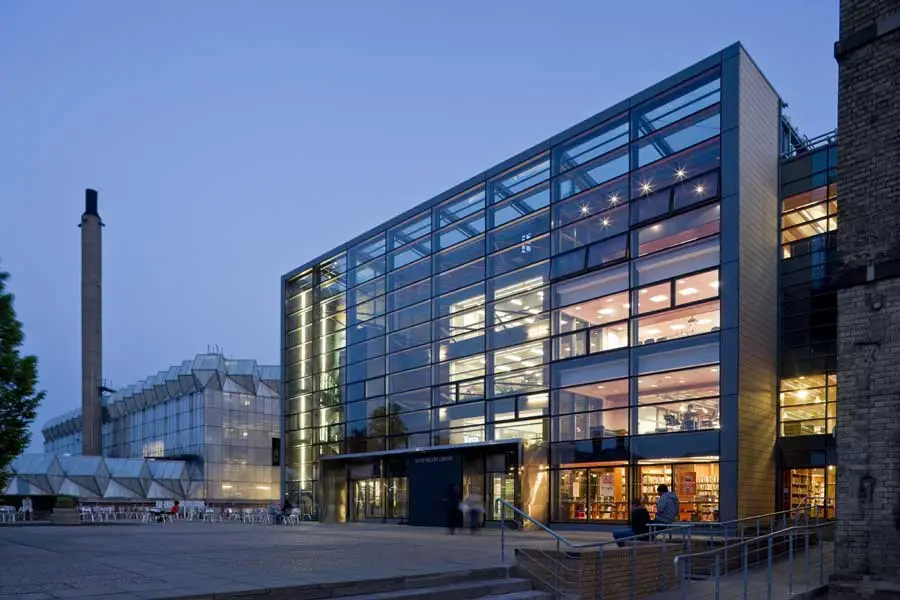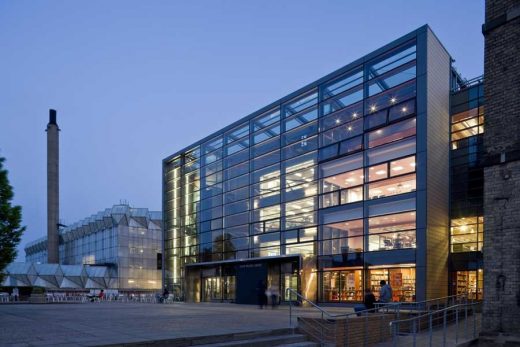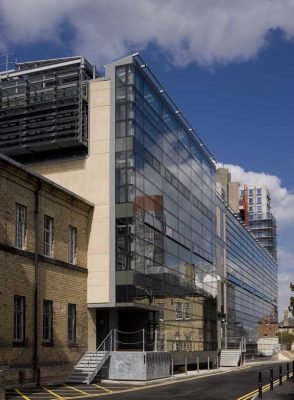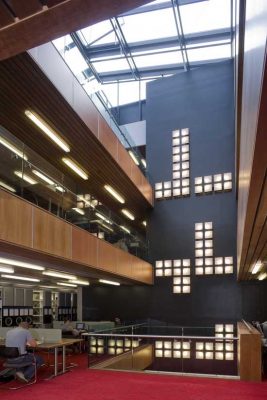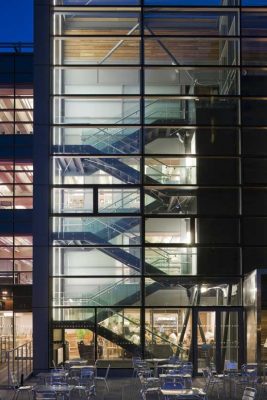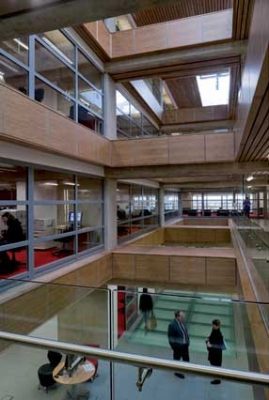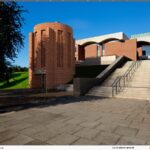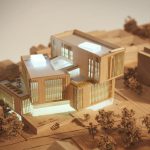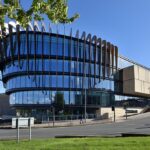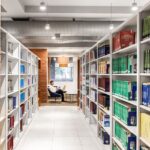David Wilson Library Photo, University of Leicester Building, Architect, Higher Education Property
University of Leicester Building
Leicestershire Higher Education Architecture Development design by Associated Architects, central England, UK
28 Oct 2008
David Wilson Library, University of Leicester
–
Design: Associated Architects LLP
Photos © Martine Hamilton Knight
David Wilson Library Leicester
Main Campus Library Extension & Refurbishment
University of Leicester
David Wilson Library Project Details
In order to select an architectural led design consultancy for their library project the University of Leicester issued briefing documents to selected companies in December 2004. This would allow competing designers to formulate a design response as part of a formal tender process to be submitted in April 2005.
Having recently won the RIBA sustainability award and designed a large health library for Birmingham City University Associated Architects brought their knowledge along with M&E designers Faber Maunsell and cost consultants Faithful+Gould to the project. Over a number of weeks a series of design workshops were held to develop a design approach that responded to the clients brief, was deliverable in terms of cost, phasing and programme and meet a BREEAM rating of a minimum very good. The key aspects of the design that developed in these workshops were as follows;
‘Maximise natural light with minimum loss of useable space’
A high priority of the brief was to radically change the internal environment of the building which remained in its mechanically ventilated deep plan 1970’s arrangement. The buildings vertical circulation was located in the centre of its 40m by 40m plan with a stair in front of a lift and toilet core. The only source of natural light was 20m away through 750mm high perimeter strip windows located at desk top level. This along with out dated finishes and direct lighting made the entire building uninspiring, gloomy, difficult to navigate and very oppressive.
Our initial reaction was to open the centre of the building to the sky, introducing rooflights and cutting holes in the floors down to ground floor level and providing a glass floor to let light into the basement. In order to demonstrate the effect of this Faber Maunsell produced a computer prediction of the light levels that could be achieved.
The effect would be dramatic and the University could see the benefit immediately. The rooflights would be incorporated into the new extension in order to make a connecting street through the entire length of the remodelled and extended library. The introduction of the atrium created two 16m wide floor plates naturally lit from both sides, closer to the best practice plan depths recommended in the British Council for Offices (BCO) guidelines.
Opportunities to increase natural light were also implemented along the perimeter as this where the majority of the readers tables were to be located. The narrow strip windows were removed and floor to ceiling glazing provided on the north entrance elevation to maximise views in from the library square and views out across Victoria Park. In other areas the window head was raised to ceiling level and opening lights provided below desk height, air being tempered with a heating coil behind a perforated metal displacement grille.
The atrium has improved internal legibility, helping users navigate the library collections much more easily. They are now more aware of the time of day and what the weather is doing outside!
Natural Ventilation
Having created a central atrium space, and located cellular spaces and computer suites requiring mechanical ventilation on the ground and first floors, we explored a mixed mode ventilation strategy. We determined that the upper floors could be naturally ventilated with controlled opening vents at the perimeter, venting air through the atrium roof using stack effect ventilation. This arrangement would be controlled by the Building Management System (BMS).
It was also programmed to provide night time purging across the heavy weight concrete construction. Careful attention was paid to security the location of openings were positioned behind grilles or mesh was added to prevent books from being thrown out by students. The sensitivity of controlled internal environmental for storing books was relaxed in order to facilitate this strategy. We actually saw that the mass of the books would help to moderate the temperatures by placing the book stacks in the centre of the floor plates the air having to pass through them on the way to the atrium rooflights.
The building being largely open plan on upper levels facilitated the ventilation strategy however it complicated the fire strategy. There was a concern that smoke from a fire low down would flood the upper floors preventing escape. This was overcome by a number of measures including compartmentation, position of escape stairs, smoke reservoir and venting through the roof and a fire alarm voice announcement system. These measures were considered worth paying for in order to deliver the vision.
Thermal Mass
The existing library designed by Castle Park Dean and Hook won an RIBA Award in 1974 and is locally listed. Part of its appeal was its exposed concrete structure which is comprised of pre-cast double T units supported by in-situ twin concrete beams and box columns. This arrangement allowed the original building services to be threaded between the structure.
The University wanted ‘a seamless design’ for any extension to the building. We took this literally and decided that suspended ceilings would not be provided and the money would be spent on a raised access floor system supplying power and data flexibly. Exposing the structure would assist in moderating the internal temperature and facilitate the night time cooling strategy.
We developed a bespoke pre-cast concrete structural solution that would resembled the 1970’s structure but could take much higher loadings and integrate multi-service chilled beams. We were also keen to make the structure as slim as possible to increase the ceiling heights. The original building had been reduced in overall height to reduce costs and it was felt oppressively low. We had to work to existing floor to floor levels to prevent the need for ramped access across floors.
Thermal Heat Gain
The orientation of the extension site, north-west to south-east meant that the building would be subject to solar gain throughout the day. In order to determine the extent Faber Maunsell produced a sun-cast model which identified three elevations were affected.
This led to the design of three different shading solutions to suit different internal uses, a twin façade, fixed glass brise soliel incorporating PV and horizontal louvre blades. The twin façade solution was driven by the need to control heat gain, glare, and maintaining high light transmission, while allowing a path for natural ventilation unaffected by the heat build up in the cavity.
This was the most complicated part of the building envelope involving the whole design team, contractor and specialist sub-contractors to determine the environmental performance was achievable. Facing almost directly south is a fixed glass louvre blade system incorporating PV cells to shade a full height glass façade beyond. A fixed horizontal shading system reduces heat gain the strip windows to the south-west.
Plan Efficiency, Retention and Re-use of Buildings
At competition stage we were tasked with designing three options for extending the library. The largest would require the demolition of a listed building the smallest would build on the adjacent car park. The former was controversial and we recommended the University took a sensitive approach incorporating the listed building for study spaces connected by an enclosed atrium.
In order to achieve the necessary area a basement level would also be provided under the extension maximising the potential of the site while being sensitive to the historic context. The scheme retained not only the existing library structure for re-use but also the adjacent Fielding Johnson Building.
The overall plan size of the library was also reduced through the use of compact shelving systems through the extension. This enabled the expansion of shelving to 38Km’s within a much smaller plan size than traditional open shelving.
BREEAM & PV
The original aspiration had been to achieve a very good rating however when the BRE assessor carried out the first review the score was close to excellent. The University saw the opportunity to improve the rating and stated that there would be no point in achieving anything other than the highest achievable. This was a clear message that the University wanted to deliver the most sustainable building possible.
Before the BREEAM assessment was completed the opportunity to incorporate photovoltaics into the project came from a research grant the University had secured. It was determined that PV could be incorporated into the Colt brise soliel system and within the atrium roof glazing. A third location would be a perfectly orientated PV array constructed on top of the new plantrooms. The University now had visible sustainable measures that would signify their environmental aspirations.
Materials
Rubber flooring a natural product
Durat sinks made of recycled materials
FSC rated timber throughout
Roofing material
Recycled demolition waste
Much of the building was prefabricated this included the pre-cast concrete superstructure, stairs, riser walls, lift shafts, terracotta and concrete cladding panels. Prefabricated plant rooms were also utilised in order that services could be installed in factory conditions improving the quality of the installation, reducing waste, and allowing them to be constructed in parallel with the main site activities. Prefabrication was promoted due to the restricted site foot-print, poor site access, to limit the impact on adjacent occupied buildings to speed up construction and provide a high quality finish.
Design Overview
Mixed mode ventilation strategy – highly efficient, locally controllable multi service chilled beams
Natural ventilation through shallow plan widths and a central atrium with stack effect ventilation
20% enhancement of u-values required by Building Regulations Part L.
Internal & external facilities for cyclists
Specification of water saving sanitary appliances
Triple glazed ‘solar wall’, brise soliel shading and integrated blinds to reduce solar gain and glare, determined through solar modelling software.
High efficiency lighting and PIR detection
Re-use of 1970’s concrete structure
Enhanced thermal performance and air-tightness
Solar shading system (PV incorporated)
Exposed thermal mass internally & night-time cooling
Enhanced accessibility lift provision and level access
Rapid vertical transportation
BS5454 Archive Repository
Offsite manufacture of plant rooms, reinforced concrete frame, lift & stair cores & concrete cladding panels
FSC rated timber
Re-cycled demolition waste
PV array (research project)
BREEAM rated excellent
Maximised daylight within the existing structure & new build using atria and full height glazing
15years collection expansion space in 38km’s of shelving (1.1 million articles)
RFID technology for self-issue and return of books
500 seat basement lecture theatre
Detailed consultation with English Heritage and the Local Planning Authority to determine the optimum development to minimise impact on adjacent historic buildings and neighbours.
Planning application 8 weeks to obtain approval
Efficient planning of library open shelving & utilisation of compact shelving systems to reduce the overall building size required.
Location: University of Leicester, England, UK
Architecture in England
Contemporary Architecture in England
Leicestershire Bridge Competition
De Montfort University Library, Leicester
–
Eva Jiricna Architects
Engineering Building, Leicester University
1959
Stirling and Gowan
Leicester University engineering laboratory
–
Stirling & Gowan
This celebrated university building may be demolished – Grade II* listed building
Leicester University College Hall buildings
–
Leslie Martin & Trevor Dannatt
Leicester University College Hall Buildings Refurbishment
2008-
Conran & Partners
Student accommodation – tower, Jarrom Street / Eastern Boulevard
2008-
Maber Associates
15 storeys
circular tower
The Charles Wilson building, University of Leicester
–
Denys Lasdun Architects
The Lasdun Building, University of Leicester
–
Denys Lasdun Architects
Leicester Theatre Architects : Rafael Vinoly
Comments / photos for the David Wilson Library Leicester Building – Leicestershire Architecture page welcome

